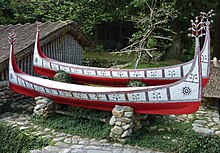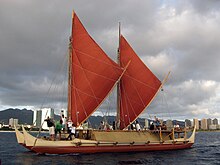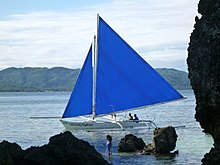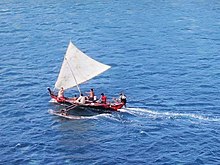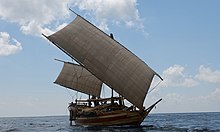Malia (canoe)
Malia (Hawaiian canoe) | |
Honolulu, Hawaii | |
| Coordinates | 21°17′30″N 157°50′5″W / 21.29167°N 157.83472°W |
|---|---|
| Area | less than one acre |
| Built | 1933 |
| Architect | James Takeo Yamasaki |
| Architectural style | Wooden dugout canoe |
| NRHP reference No. | 93001385[1] |
| Added to NRHP | December 17, 1993 |
Mālia is a Hawaiian-style wooden racing
Background
Design
Mālia, a ~40-ft., 400-lb. canoe designed by James Takeo Yamasaki,
An interesting sidelight of the first Catalina-to-Newport race in 1959 was the alleged pirating of a fiberglass plug of the Malia. This shell, reportedly taken without authorization while the Malia awaited shipment back to Hawaiʻi, was later made into a mold. From this mold, and the hulls that came from it, other molds were made. The majority of the fiberglass canoes in use in Hawaiʻi and California today have been made from these molds. Thus the Malia inadvertently sired a noble fleet of fiberglass-and-resin-canoes.[7]
In 1960, a California-made fiberglass model of the Mālia competed in the annual paddling race across the
Usage and importance
The term Malia canoe now refers to a class of Hawaiian-style outrigger canoes that follow the design of the original Mālia, even when made of fiberglass. Every serious outrigger canoe club, however, aims to acquire at least one Mālia made of koa wood and other traditional materials.[2][8][9][10][11]
References
- ^ a b "National Register Information System". National Register of Historic Places. National Park Service. July 9, 2010.
- ^ a b c d e f Steve West (2009). "FAQ: Outrigger Canoes - Types Used for Racing". KANUculture: Ocean Sports Media Services. Archived from the original on 2009-07-09. Retrieved 2009-06-16.
- ^ Holmes 1993, p. 125
- ^ "Volcano Gallery: Hawaiian Canoes". Retrieved 2009-06-16.
- ^ a b Holmes 1993, p.128
- ^ "Waikiki Surf Club: History about the Canoes". Archived from the original on 2004-07-26. Retrieved 2009-06-16.
- ^ Homes 1993, p.146
- ^ "Kihei Canoe Club: Canoes". Retrieved 2009-06-16.
- ^ "Oceanside Outrigger Canoe Club: Our Canoes". Retrieved 2009-06-16.
- ^ "He'e Nalu Outrigger Canoe Club, Marin-Sonoma: About Us". Archived from the original on 2009-10-15. Retrieved 2009-06-16.
- ^ "Marina Del Ray Outrigger Canoe Club: Racing Outrigger Canoe Designs - Origins to the Present". Archived from the original on 2008-09-08. Retrieved 2009-06-16.
Further reading
- Clark, John R. K. (2001). Hawaiʻi Place Names: Shores, Beaches, and Surf Sites. ISBN 0-8248-2451-2.
- Holmes, Tommy (1993) [1981]. The Hawaiian Canoe (Second ed.). Editions Limited. ISBN 0-915013-15-0.
- McHugh, Paul (1997-11-20). "Polynesia's Past Shows Up on Bay. Outrigger canoe clubs paddle to ancient rhythms". San Francisco Chronicle. Retrieved 2009-06-19.

